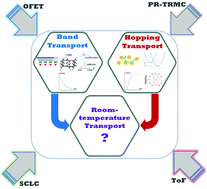当前位置:
X-MOL 学术
›
Phys. Chem. Chem. Phys.
›
论文详情
Our official English website, www.x-mol.net, welcomes your
feedback! (Note: you will need to create a separate account there.)
Dichotomy between the band and hopping transport in organic crystals: insights from experiments
Physical Chemistry Chemical Physics ( IF 2.9 ) Pub Date : 2017-09-11 00:00:00 , DOI: 10.1039/c7cp05297a I. Yavuz 1, 2, 3, 4
Physical Chemistry Chemical Physics ( IF 2.9 ) Pub Date : 2017-09-11 00:00:00 , DOI: 10.1039/c7cp05297a I. Yavuz 1, 2, 3, 4
Affiliation

|
The molecular understanding of charge-transport in organic crystals has often been tangled with identifying the true dynamical origin. While in two distinct cases where complete delocalization and localization of charge-carriers are associated with band-like and hopping-like transports, respectively, their possible coalescence poses some mystery. Moreover, the existing models are still controversial at ambient temperatures. Here, we review the issues in charge-transport theories of organic materials and then provide an overview of prominent transport models. We explored ∼60 organic crystals, the single-crystal hole/electron mobilities of which have been predicted by band-like and hopping-like transport models, separately. Our comparative results show that at room-temperature neither of the models are exclusively capable of accurately predicting mobilities in a very broad range. Hopping-like models well-predict experimental mobilities around μ ∼ 1 cm2 V−1 s−1 but systematically diverge at high mobilities. Similarly, band-like models are good at μ > ∼50 cm2 V−1 s−1 but systematically diverge at lower mobilities. These results suggest the development of a unique and robust room-temperature transport model incorporating a mixture of these two extreme cases, whose relative importance is associated with their predominant regions. We deduce that while band models are beneficial for rationally designing high mobility organic-semiconductors, hopping models are good to elucidate the charge-transport of most organic-semiconductors.
中文翻译:

带和跳跃在有机晶体中的迁移之间的二分法:来自实验的见解
分子对有机晶体中电荷传输的理解常常与确定真正的动力学起源纠缠不清。虽然在两种完全不同的情况下,电荷载流子的完全离域和局部化分别与带状和跳跃型传输相关,但它们可能的合并却带来了一些神秘感。而且,现有模型在环境温度下仍存在争议。在这里,我们回顾了有机材料电荷传输理论中的问题,然后概述了著名的传输模型。我们探索了约60种有机晶体,它们的单晶空穴/电子迁移率已分别通过带状和跳跃状传输模型预测。我们的比较结果表明,在室温下,这两个模型都不是唯一能够在很宽的范围内准确预测迁移率的模型。类似跳跃的模型可以很好地预测周围的实验迁移率μ〜1 cm 2 V -1 s -1但在高迁移率时会系统地发散。类似地,带状模型在μ >〜50 cm 2 V -1 s -1时很好,但在较低的迁移率时系统地发散。这些结果表明开发了结合了这两种极端情况的独特而强大的室温传输模型,这两种极端情况的相对重要性与其主要地区有关。我们推论,虽然能带模型对于合理设计高迁移率有机半导体是有益的,但跳跃模型对于阐明大多数有机半导体的电荷传输是很好的。
更新日期:2017-09-21
中文翻译:

带和跳跃在有机晶体中的迁移之间的二分法:来自实验的见解
分子对有机晶体中电荷传输的理解常常与确定真正的动力学起源纠缠不清。虽然在两种完全不同的情况下,电荷载流子的完全离域和局部化分别与带状和跳跃型传输相关,但它们可能的合并却带来了一些神秘感。而且,现有模型在环境温度下仍存在争议。在这里,我们回顾了有机材料电荷传输理论中的问题,然后概述了著名的传输模型。我们探索了约60种有机晶体,它们的单晶空穴/电子迁移率已分别通过带状和跳跃状传输模型预测。我们的比较结果表明,在室温下,这两个模型都不是唯一能够在很宽的范围内准确预测迁移率的模型。类似跳跃的模型可以很好地预测周围的实验迁移率μ〜1 cm 2 V -1 s -1但在高迁移率时会系统地发散。类似地,带状模型在μ >〜50 cm 2 V -1 s -1时很好,但在较低的迁移率时系统地发散。这些结果表明开发了结合了这两种极端情况的独特而强大的室温传输模型,这两种极端情况的相对重要性与其主要地区有关。我们推论,虽然能带模型对于合理设计高迁移率有机半导体是有益的,但跳跃模型对于阐明大多数有机半导体的电荷传输是很好的。











































 京公网安备 11010802027423号
京公网安备 11010802027423号